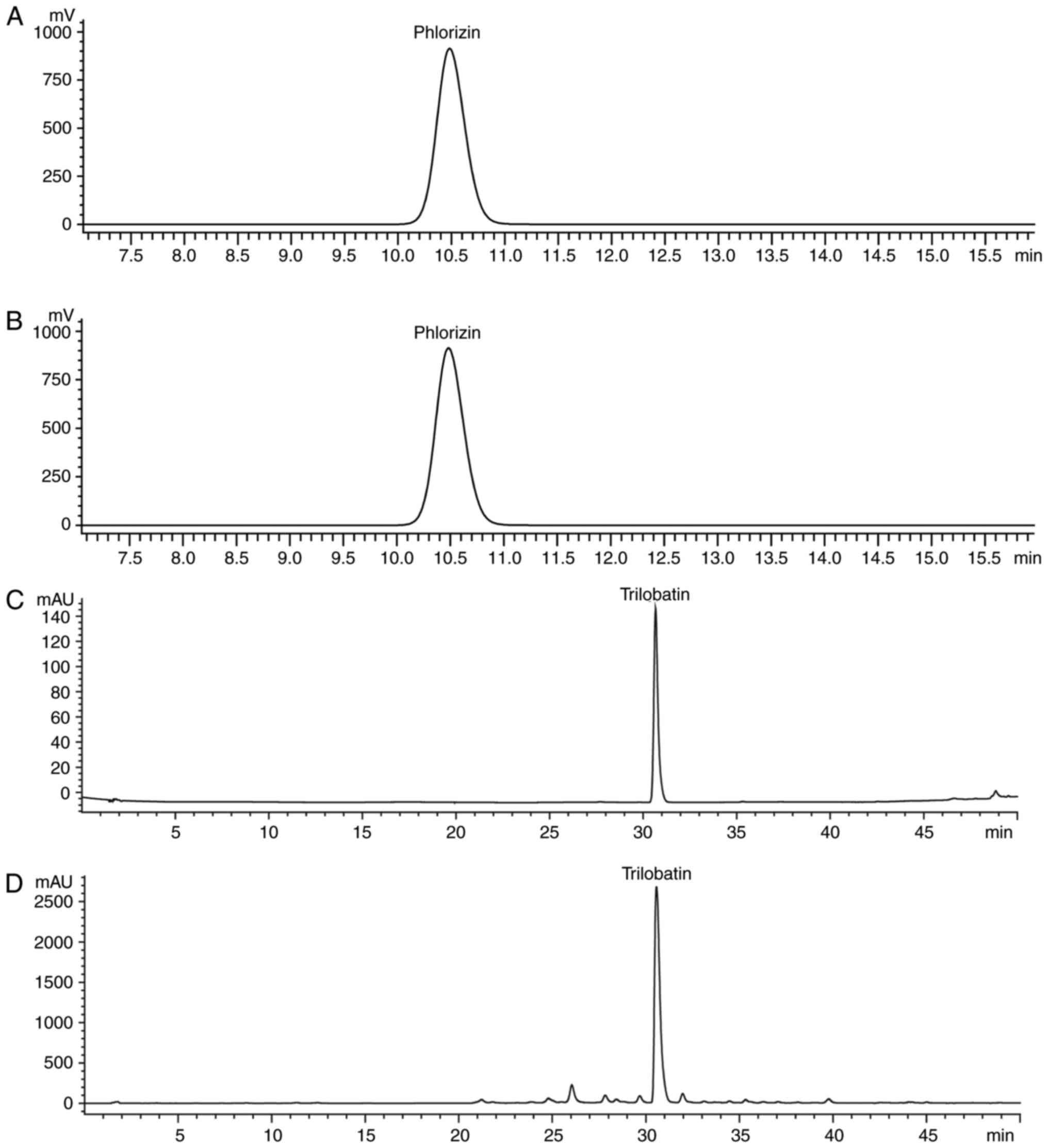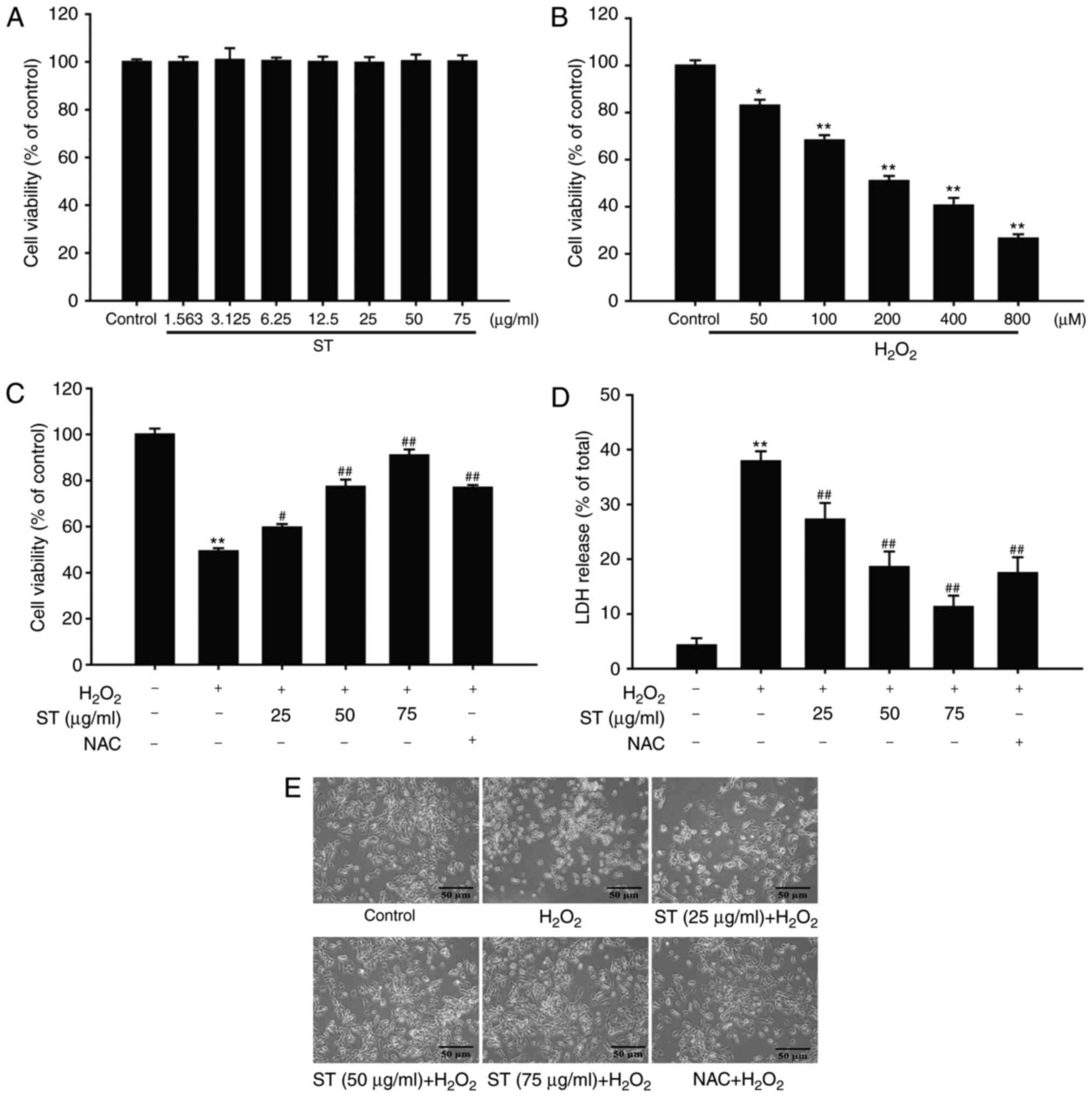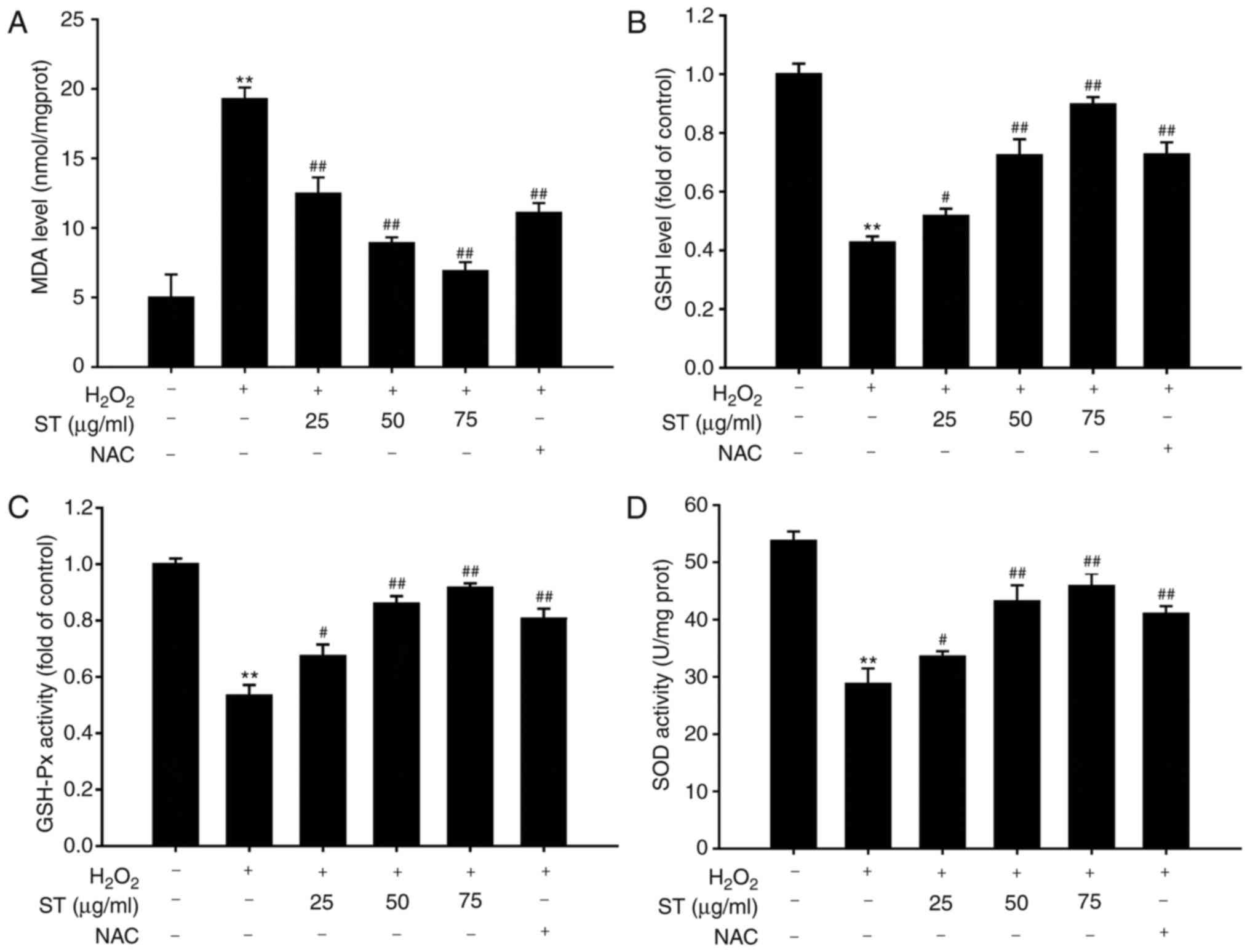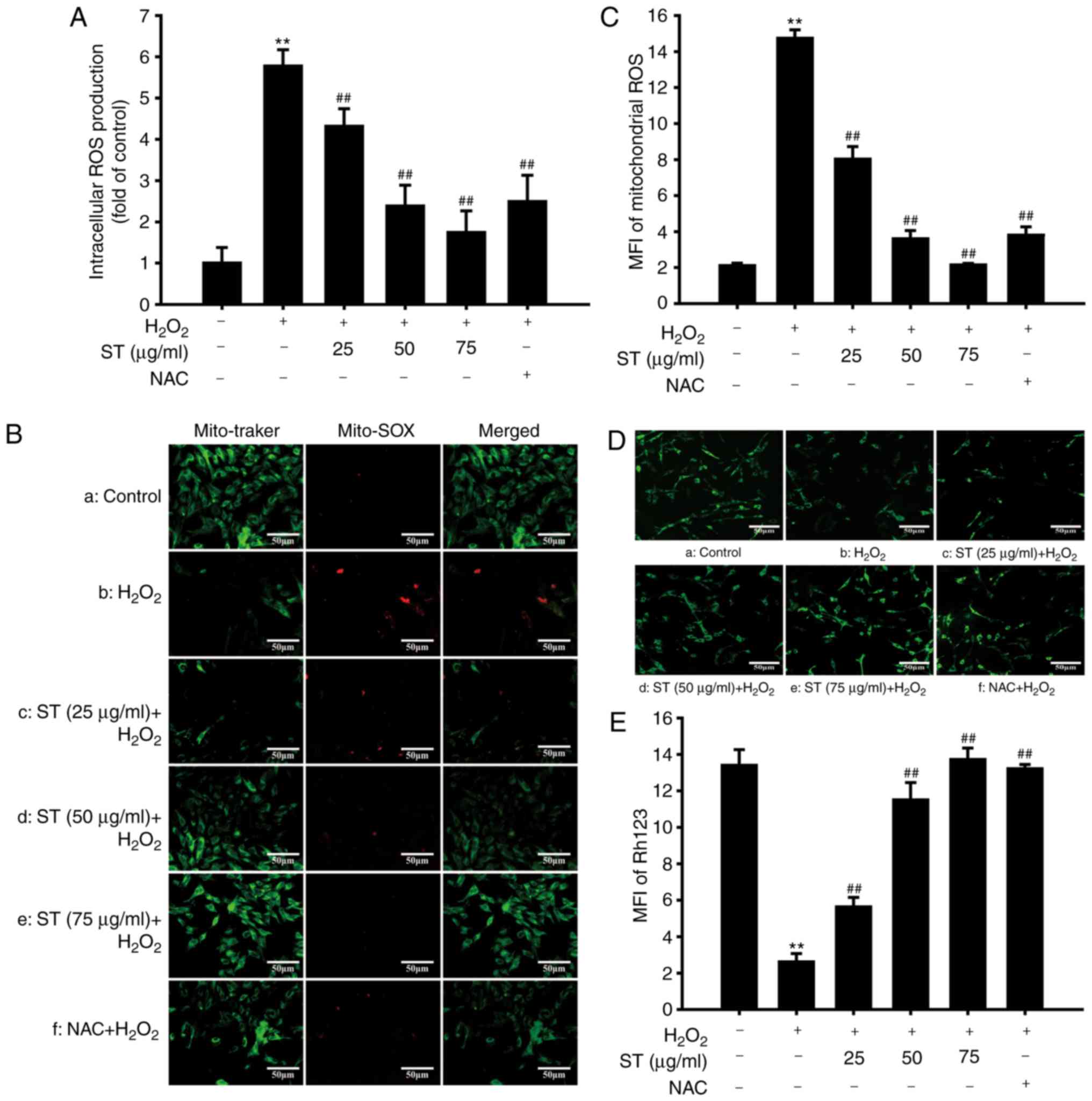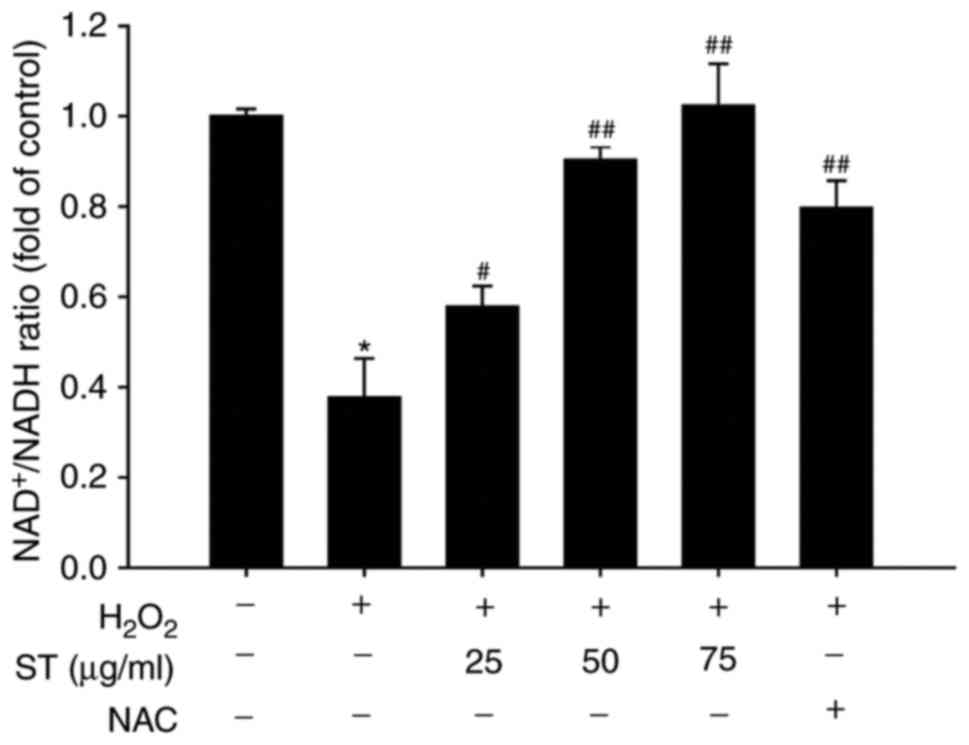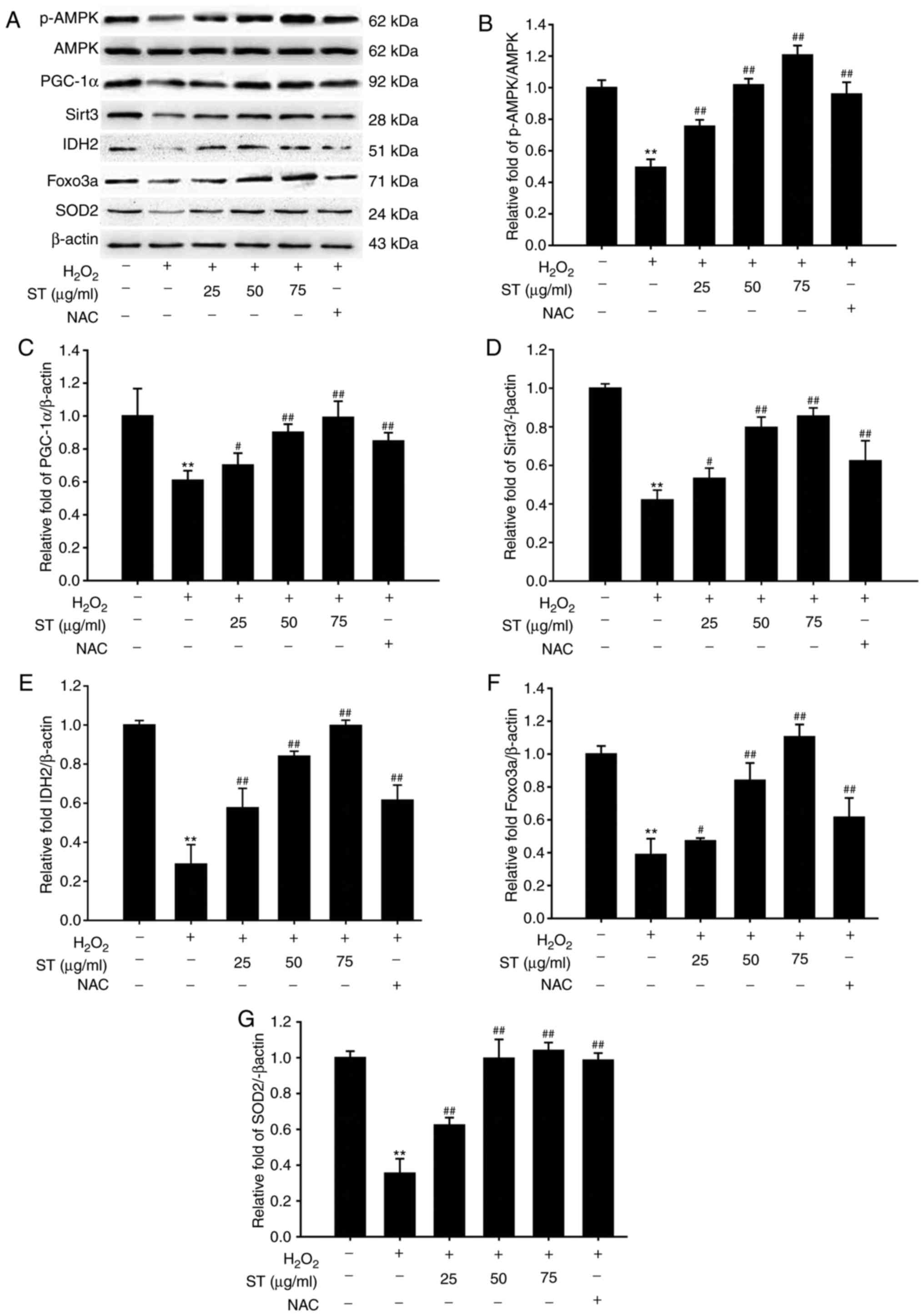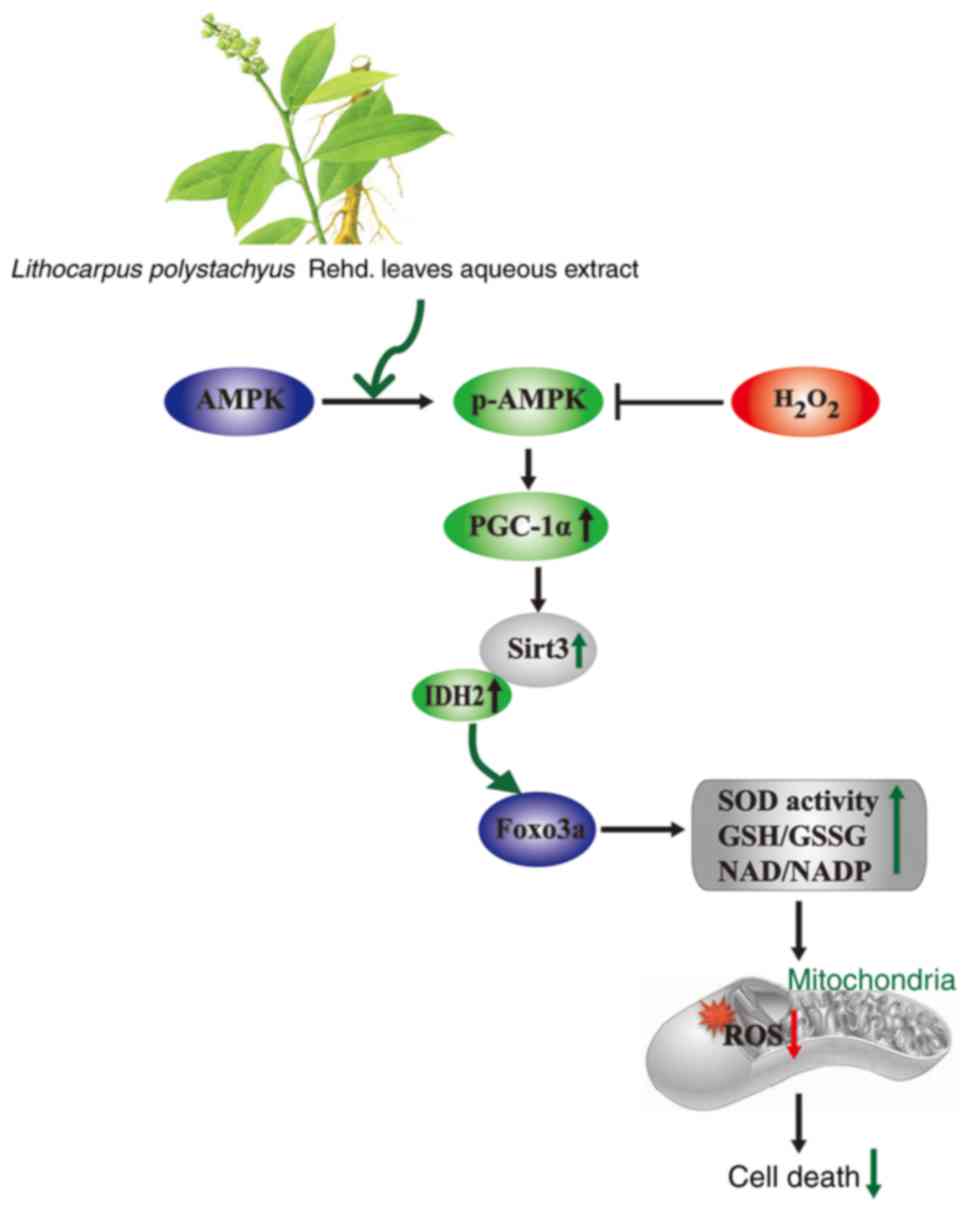|
1
|
Liu L, Zhang K, Sandoval H, Yamamoto S,
Jaiswal M, Sanz E, Li Z and Hui J: Glial lipid droplets and ROS
induced by mitochondrial defects promote neurodegeneration. Cell.
160:177–190. 2015. View Article : Google Scholar : PubMed/NCBI
|
|
2
|
Zhang JX, Wang R, Xi J, Shen L, Zhu AY, Qi
Q, Wang QY, Zhang LJ, Wang FC, Lü HZ and Hu JG: Morroniside
protects SK-N-SH human neuroblastoma cells against
H2O2-induced damage. Int J Mol Med.
39:603–612. 2017. View Article : Google Scholar : PubMed/NCBI
|
|
3
|
Hanschmann EM, Godoy JR, Berndt C,
Hudemann C and Lillig CH: Thioredoxins, glutaredoxins, and
peroxire-doxins-molecular mechanisms and health significance: From
cofactors to antioxidants to redox signaling. Antioxid Redox
Signal. 19:1539–1605. 2013. View Article : Google Scholar : PubMed/NCBI
|
|
4
|
Tseng AH, Shieh SS and Wang DL: SIRT3
deacetylates FOXO3 to protect mitochondria against oxidative
damage. Free Radic Biol Med. 63:222–234. 2013. View Article : Google Scholar : PubMed/NCBI
|
|
5
|
Wang Y, Wang Y, Li J, Hua L, Han B, Zhang
Y, Yang X, Zeng Z, Bai H, Yin H and Lou J: Effects of caffeic acid
on learning deficits in a model of Alzheimer's disease. Int J Mol
Med. 38:869–875. 2016. View Article : Google Scholar : PubMed/NCBI
|
|
6
|
Wang J, Huang Y, Li K, Chen Y, Vanegas D,
McLamore ES and Shen Y: Leaf extract from Lithocarpus polystachyus
Rehd promote glycogen synthesis in T2DM mice. PLoS One.
11:e01665572016. View Article : Google Scholar
|
|
7
|
Hou SZ, Chen SX, Huang S, Jiang DX, Zhou
CJ, Chen CQ, Liang YM and Lai XP: The hypoglycemic activity of
Lithocarpus polystachyus Rehd leaves in the experimental
hyperglycemic rats. J Ethnopharmacol. 138:142–149. 2011. View Article : Google Scholar : PubMed/NCBI
|
|
8
|
Hou SZ, Xu SJ, Jiang DX, Chen SX, Wang LL,
Huang S and Lai XP: Effect of the flavonoid fraction of Lithocarpus
polys-tachyus Rehd on spontaneously hypertensive and normotensive
rats. J Ethnopharmacol. 143:441–447. 2012. View Article : Google Scholar : PubMed/NCBI
|
|
9
|
Zhou CJ, Huang S, Liu JQ, Qiu SQ, Xie FY,
Song HP, Li YS, Hou SZ and Lai XP: Sweet tea leaves extract
improves leptin resistance in diet-induced obese rats. J
Ethnopharmacol. 145:386–392. 2013. View Article : Google Scholar
|
|
10
|
Gao XY, Wang SN, Yang XH, Lan WJ, Chen ZW,
Chen JK, Xie JH, Han YF, Pi RB and Yang XB: Gartanin protects
neurons against glutamate-induced cell death in HT22 cells:
Independence of Nrf-2 but involvement of HO-1 and AMPK. Neurochem
Res. 41:2267–2277. 2016. View Article : Google Scholar : PubMed/NCBI
|
|
11
|
Cheng L, Li B, Chen X, Su J, Wang H, Yu S
and Zheng Q: CTRP9 induces mitochondrial biogenesis and protects
high glucose-induced endothelial oxidative damage via
AdipoR1-SIRT1-PGC-1α activation. Biochem Biophys Res Commun.
477:685–691. 2016. View Article : Google Scholar : PubMed/NCBI
|
|
12
|
Kincaid B and Bossy-Wetzel E: Forever
young: SIRT3 a shield against mitochondrial meltdown, aging, and
neurodegeneration. Front Aging Neurosci. 5:482013. View Article : Google Scholar : PubMed/NCBI
|
|
13
|
Guan Y, Cui ZJ, Sun B, Han LP, Li CJ and
Chen LM: Celastrol attenuates oxidative stress in the skeletal
muscle of diabetic rats by regulating the AMPK-PGC1α-SIRT3
signaling pathway. Int J Mol Med. 37:1229–1238. 2016. View Article : Google Scholar : PubMed/NCBI
|
|
14
|
Wang Q, Li L, Li CY, Pei Z, Zhou M and Li
N: SIRT3 protects cells from hypoxia via PGC-1α- and
MnSOD-dependent pathways. Neuroscience. 286:109–121. 2015.
View Article : Google Scholar
|
|
15
|
Rangarajan P, Karthikeyan A, Lu J, Ling EA
and Dheen ST: Sirtuin 3 regulates Foxo3a-mediated antioxidant
pathway in microglia. Neuroscience. 311:398–414. 2015. View Article : Google Scholar : PubMed/NCBI
|
|
16
|
Dong H, Ning Z, Yu L, Li L, Lin L and
Huang J: Preparative separation and identification of the flavonoid
phlorhizin from the crude extract of Lithocarpus polystachyus Rehd.
Molecules. 12:552–562. 2007. View Article : Google Scholar : PubMed/NCBI
|
|
17
|
Chen TY, Chi KH, Wang JS, Chien CL and Lin
WW: Reactive oxygen species are involved in FasL-induced
caspase-independent cell death and inflammatory responses. Free
Radic Biol Med. 46:643–655. 2009. View Article : Google Scholar
|
|
18
|
Ishii T, Takanashi Y, Sugita K, Miyazawa
M, Yanagihara R, Yasuda K, Onouchi H, Kawabe N, Nakata M, Yamamoto
Y, et al: Endogenous reactive oxygen species cause astrocyte
defects and neuronal dysfunctions in the hippocampus: A new model
for aging brain. Aging Cell. 16:39–51. 2017. View Article : Google Scholar :
|
|
19
|
Gao JM, Li R, Zhang L, Jia LL, Ying XX,
Dou DQ, Li JC and Li HB: Cuscuta chinensis seeds water extraction
protecting murine osteoblastic MC3T3-E1 cells against tertiary
butyl hydroperoxide induced injury. J Ethnopharmacol. 148:587–595.
2013. View Article : Google Scholar : PubMed/NCBI
|
|
20
|
Yang YY, Sun XT, Li ZX, Chen WY, Wang X,
Liang ML, Shi H, Yang ZS and Zeng WT: Protective effect of
angiotensin-(1-7) against hyperglycaemia-induced injury in H9c2
cardiomyoblast cells via the PI3KAkt signaling pathway. Int J Mol
Med. 41:1283–1292. 2018.
|
|
21
|
Roelofs BA, Ge SX, Studlack PE and Polster
BM: Low micromolar concentrations of the superoxide probe MitoSOX
uncouple neural mitochondria and inhibit complex IV. Free Radic
Biol Med. 86:250–258. 2015. View Article : Google Scholar : PubMed/NCBI
|
|
22
|
Lee Y, Heo G, Lee KM, Kim AH, Chung KW, Im
E, Chung HY and Lee J: Neuroprotective effects of 2,4-dinitrophenol
in an acute model of Parkinson's disease. Brain Res. 1663:184–193.
2017. View Article : Google Scholar : PubMed/NCBI
|
|
23
|
Hong YA, Lim JH, Kim MY, Kim Y, Park HS,
Kim HW, Choi BS, Chang YS, Kim HW, Kim TY and Park CW:
Extracellular superoxide dismutase attenuates renal oxidative
stress through the activation of adenosine monophosphate-activated
protein kinase in diabetic nephropathy. Antioxid Redox Signal.
28:1543–1561. 2018. View Article : Google Scholar
|
|
24
|
Gao C, Chang P, Yang L, Wang Y, Zhu S,
Shan H, Zhang M and Tao L: Neuroprotective effects of hydrogen
sulfide on sodium azide-induced oxidative stress in PC12 cells. Int
J Mol Med. 41:242–250. 2018.
|
|
25
|
Di Domenico F, Barone E, Perluigi M and
Butterfield DA: The triangle of death in Alzheimer's disease brain:
The aberrant cross-talk among energy metabolism, mammalian target
of rapamycin signaling, and protein homeostasis revealed by redox
proteomics. Antioxid Redox Signal. 26:364–387. 2017. View Article : Google Scholar
|
|
26
|
Wang X, Dong W, Yuan B, Yang Y, Yang D,
Lin X, Chen C and Zhang W: Vitamin E confers cytoprotective effects
on cardiomyocytes under conditions of heat stress by increasing the
expression of metallothionein. Int J Mol Med. 37:1429–1436. 2016.
View Article : Google Scholar : PubMed/NCBI
|
|
27
|
Gao J, Deng Y, Yin C, Liu Y, Zhang W, Shi
J and Gong Q: Icariside II, a novel phosphodiesterase 5 inhibitor,
protects against H2O2-induced PC12 cells
death by inhibiting mitochondria-mediated autophagy. J Cell Mol
Med. 21:375–386. 2017. View Article : Google Scholar
|
|
28
|
Zhong J, Xu C, Gabbay-Benziv R, Lin X and
Yang P: Superoxide dismutase 2 overexpression alleviates maternal
diabetes-induced neural tube defects, restores mitochondrial
function and suppresses cellular stress in diabetic embryopathy.
Free Radic Biol Med. 96:234–244. 2016. View Article : Google Scholar : PubMed/NCBI
|
|
29
|
Rottenberg H and Hoek JB: The path from
mitochondrial ROS to aging runs through the mitochondrial
permeability transition pore. Aging Cell. 16:943–955. 2017.
View Article : Google Scholar : PubMed/NCBI
|
|
30
|
Zhang JY, Deng YN, Zhang M, Su H and Qu
QM: SIRT3 acts as a neuroprotective agent in rotenone-induced
Parkinson cell model. Neurochem Res. 41:1761–1773. 2016. View Article : Google Scholar : PubMed/NCBI
|
|
31
|
Yin J, Han P, Tang Z, Liu Q and Shi J:
Sirtuin 3 mediates neuro-protection of ketones against ischemic
stroke. J Cereb Blood Flow Metab. 35:1783–1789. 2015. View Article : Google Scholar : PubMed/NCBI
|
|
32
|
Zhou X, Chen M, Zeng X, Yang J, Deng H, Yi
L and Mi MT: Resveratrol regulates mitochondrial reactive oxygen
species homeostasis through Sirt3 signaling pathway in human
vascular endothelial cells. Cell Death Dis. 5:e15762014. View Article : Google Scholar : PubMed/NCBI
|
|
33
|
Guo Q, Li S, Xie Y, Zhang Q, Liu M, Xu Z,
Sun H and Yang Y: The NAD+-dependent deacetylase,
Bifidobacterium longum Sir2 in response to oxidative stress by
deacetylating SigH (sigmaH) and FOXO3a in Bifidobacterium longum
and HEK293T cell respectively. Free Radic Biol Med. 108:929–939.
2017. View Article : Google Scholar : PubMed/NCBI
|
|
34
|
Guo Y, Li Z, Shi C, Li J, Yao M and Chen
X: Trichostatin A attenuates oxidative stress-mediated myocardial
injury through the FoxO3a signaling pathway. Int J Mol Med.
40:999–1008. 2017. View Article : Google Scholar : PubMed/NCBI
|
|
35
|
Yu L, Gong B, Duan W, Fan C, Zhang J, Li
Z, Xue X, Xu Y, Meng D, Li B, et al: Melatonin ameliorates
myocardial ischemia/reperfusion injury in type 1 diabetic rats by
preserving mitochondrial function: Role of AMPK-PGC-1α-SIRT3
signaling. Sci Rep. 7:413372017. View Article : Google Scholar
|
|
36
|
Dai SH, Chen T, Wang YH, Zhu J, Luo P, Rao
W, Yang YF, Fei Z and Jiang XF: Sirt3 attenuates hydrogen
peroxide-induced oxidative stress through the preservation of
mitochondrial function in HT22 cells. Int J Mol Med. 34:1159–1168.
2014. View Article : Google Scholar : PubMed/NCBI
|
|
37
|
Karnewar S, Neeli PK, Panuganti D,
Kotagiri S, Mallappa S, Jain N, Jerald MK and Kotamraju S:
Metformin regulates mitochondrial biogenesis and senescence through
AMPK mediated H3K79 methylation: Relevance in age-associated
vascular dysfunction. Biochim Biophys Acta. 1864:1115–1128. 2018.
View Article : Google Scholar
|



